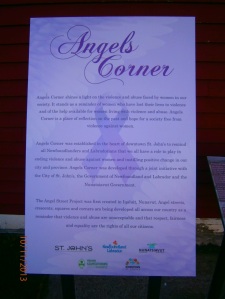In 1993, in the first survey of its kind, Statistics Canada found that 51% of Canadian women had experienced some form of violence.
Eighteen years later in 2011, one in every fifty women under the age 44 was a victim of violent crime. These were only the reported cases. Many more undoubtedly went unreported.
Evidently, there continues to be a serious problem with violence against women in Canada.

Source:Statistics Canada website.
Activism
Many women’s organizations argue not enough is being done to stop this violence from occurring.
There is activism taking place. The Take Back the Night marches oppose rape and violence against women. White Ribbon, a male organisation, campaigns against violence against women. Sisters in Spirit is a campaign specifically created to bring attention to murdered and missing Aboriginal women in Canada . These annual campaigns are important in supporting abused women. However, examples of violence against women continue to be reported. This suggests these efforts are simply not enough.
Active Forgetting
Another example of resistance are the memorials erected in remembrance of women killed by violence. However, due to a process called “active forgetting” (1) these are often sites of controversy, This process of normalizes violence against women by treating attacks as individual acts rather than part of a continuing series, and so effectively downplays the severity and systemic nature of the problem.
The essay defines active forgetting as “repression through shifting out of conscious memory to the level of naturalized behaviour learned, embodied, and internalized through ritual processes and habitual action.” (Bold., Leach., Knowles., p. 127) Essentially, the act of violence is repressed, rather than challenged. For example, in the case of domestic violence, an abused woman may use active forgetting to keep her family together, at the cost of her safety.
This act of repression is extremely dangerous. It can silence women in any number of ways: including fear of further violence if they were to speak out, concern over their claims not being taken seriously, or simply believing violence to be acceptable or forgivable if it happens under certain circumstances (the perpetrator was intoxicated/furious/not acting like their usual selves.)
Various Forms of Violence
Women can suffer from several different types of violence. These can include, but are by no means limited to, physical violence, emotional abuse, femicide, and criminal harassment such as stalking. Due to their sheer number, violence against women is difficult to eradicate, as not all types can be easily identified by people outside the relationship.
It also varies between age groups. For instance, the highest rates of sexual violence, criminal harassment, femicide, and intimate partner violence are recorded by women under the age of 25. Meanwhile, over a five year period, 11% of pregnant women reported assault in marriage. This is another challenge in stopping violence against women as some groups of women are more difficult to access than others.
Moving Forward
It is vital that improvements are made. We need more regular surveys of the situation. In Canada surveys have not been conducted on a regular enough basis to understand whether or not violence against women is truly being challenged effectively.
Further, it is vital to educate people on recognizing that there are many kinds of violence, and not all of them are visible. Sexual violence or psychological abuse are easily hidden and can be challenging to expose. The most effective way to combat violence is to keep it in the public consciousness.
Violence against women is not an occasional event happening to someone else, somewhere else, but a very real issue, and something that thousands of women experience on a daily basis.
1. Defined in the essay C. Bold, R. Knowles and B. Leach, “Feminist Memorializing and Cultural Countermemory: The Case of Marianne’s Park.”
— Elizabeth Butler
Further reading:
On missing and murdered Aboriginal women consult https://inequalitygaps.org/first-takes/gender-roles-of-women-since-1945/murdered-and-missing-aboriginal-women-in-canada/
Bold, C., Knowles, R., and Leach, B. “Feminist Memorializing and Cultural Countermemory: The Case of Marianne’s Park” Journal of Women in Culture & Society, Autumn 2002, Vol. 28 Issue 1, p125, 24 p.
http://www.jstor.org/stable/10.1086/340905
Statistics Canada’s 2011 report:
http://www.statcan.gc.ca/daily-quotidien/130225/dq130225a-eng.pdf
The Canadian Centre for Policy Alternatives review of resources available to women across Canada:
Canadian Research Institute for the Advancement of Women fact sheet:
http://www.criaw-icref.ca/sites/criaw/files/VAW_ENG_long_final_0.pdf
